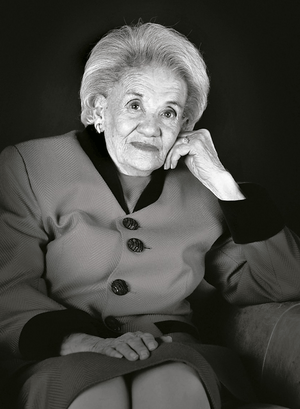Lidia Gueiler facts for kids
Quick facts for kids
Lidia Gueiler
|
|
|---|---|

Gueiler in January 2009
|
|
| 56th President of Bolivia | |
| In office 16 November 1979 – 17 July 1980 |
|
| Vice President | Vacant |
| Preceded by | Alberto Natusch |
| Succeeded by | Luis García Meza |
| President of the Chamber of Deputies | |
| In office 4 August 1979 – 16 November 1979 |
|
| Preceded by | Jorge Ríos Gamarra |
| Succeeded by | José Zegarra Cerruto |
| Personal details | |
| Born | 28 August 1921 Cochabamba, Bolivia |
| Died | 9 May 2011 (aged 89) La Paz, Bolivia |
| Political party | Revolutionary Party of the Nationalist Left (1963–1979) |
| Other political affiliations |
Revolutionary Nationalist Movement (1948–1963) Revolutionary Party of the National Left – Gueiler (1979–1980) Revolutionary Left Front (1978–1979) Revolutionary Left Movement (1989–1993) |
| Spouses | Mareiriam Pérez Ramírez Edwin Möller Pacieri |
| Children | María Teresa |
| Parents | Moisés Gueiler Raquel Tejada |
| Relatives | José Luis Tejada Sorzano (uncle) Raquel Welch (cousin) Luis García Meza (cousin) |
| Awards | |
| Signature | |
Lidia Gueiler Tejada (born August 28, 1921 – died May 9, 2011) was an important Bolivian politician. She made history as the 56th president of Bolivia, serving for a short time from 1979 to 1980. She was the very first woman to become Head of State in Bolivia. She was also the second woman to lead a country in the history of the Americas, after Isabel Perón of Argentina.
Lidia Gueiler was also the cousin of the famous American actress Raquel Welch.
Contents
Early Life and Political Beginnings
Lidia Gueiler was born in Cochabamba, a city in Bolivia. Her father, Moisés Gueiler Grunewelt, was an immigrant from Germany. Her mother, Raquel Tejada Albornoz, was Bolivian. Lidia studied at the Instituto Americano in Cochabamba and earned a degree in arts.
In the 1940s, Lidia joined a political group called the Movimiento Nacionalista Revolucionario (MNR). This group aimed to bring big changes to Bolivia.
Serving in Congress
When the MNR party gained power after the 1952 National Revolution, Lidia Gueiler became a member of the Congress of Bolivia. She worked in Congress from 1956 until 1964.
In 1964, the MNR government was overthrown by military generals. Because of this, Lidia had to leave Bolivia and live in other countries for about 15 years. During this time, she joined another political group called the Revolutionary Party of the Nationalist Left (PRIN). She also became a leader in the Revolutionary Left Front.
Return to Bolivia and Leadership Role
Lidia Gueiler came back to Bolivia in 1979. She ran for Congress again and was elected to lead the Chamber of Deputies. This is like being the speaker of the lower house of Congress.
A Time of Political Uncertainty
In 1979, Bolivia faced a difficult political situation. No candidate in the presidential elections received enough votes to win directly. So, it was up to Congress to choose the next president. However, the members of Congress could not agree on a leader.
To solve this, Dr. Wálter Guevara, who was the head of the Senate, was chosen as a temporary president. He was meant to hold new elections in 1980. But after only a short time, General Alberto Natusch took power in a military takeover.
A Nation Resists
The people of Bolivia did not accept General Natusch's rule. Many citizens, led by a powerful workers' union called the Central Obrera Boliviana, went on a nationwide strike. This strong resistance forced General Natusch to step down after just 16 days. The only condition he asked for was that Dr. Guevara not return as president.
Becoming Interim President
With Dr. Guevara out, a new temporary leader was needed. Lidia Gueiler, as the head of the Chamber of Deputies, was chosen to be the new interim President of Bolivia. Her main job was to organize new elections, which were held on June 29, 1980.
Overthrown by a Military Takeover
Before the winners of the 1980 elections could take their places, Lidia Gueiler's government was overthrown. Her own cousin, General Luis García Meza Tejada, led a military takeover. After this, Lidia Gueiler left Bolivia and lived in France. She returned to her home country when the military government ended in 1982.
Later Life and Activities
After her time as president, Lidia Gueiler continued to serve Bolivia in other important ways. She became an ambassador for Bolivia in several countries, including Colombia, West Germany, and Venezuela. She retired from public life in the mid-1990s.
Lidia Gueiler was a strong supporter of women's rights in Bolivia throughout her life. She also wrote two books: La mujer y la revolución (The Woman and the Revolution) in 1960 and her autobiography, Mi pasión de lideresa (My Passion as a Leader), in 2000. She supported Evo Morales in the 2005 presidential election.
In June 2009, Lidia Gueiler became the honorary president of the Human Rights Foundation in Bolivia. She received several awards for her work, including the Order of the Condor of the Andes Grand Cross and the United Nations Woman of the Year award in 1979.
Death
Lidia Gueiler passed away on May 9, 2011, in La Paz, Bolivia, after a long illness. She was 89 years old.
See also
 In Spanish: Lidia Gueiler para niños
In Spanish: Lidia Gueiler para niños
- Cabinet of Lidia Gueiler

